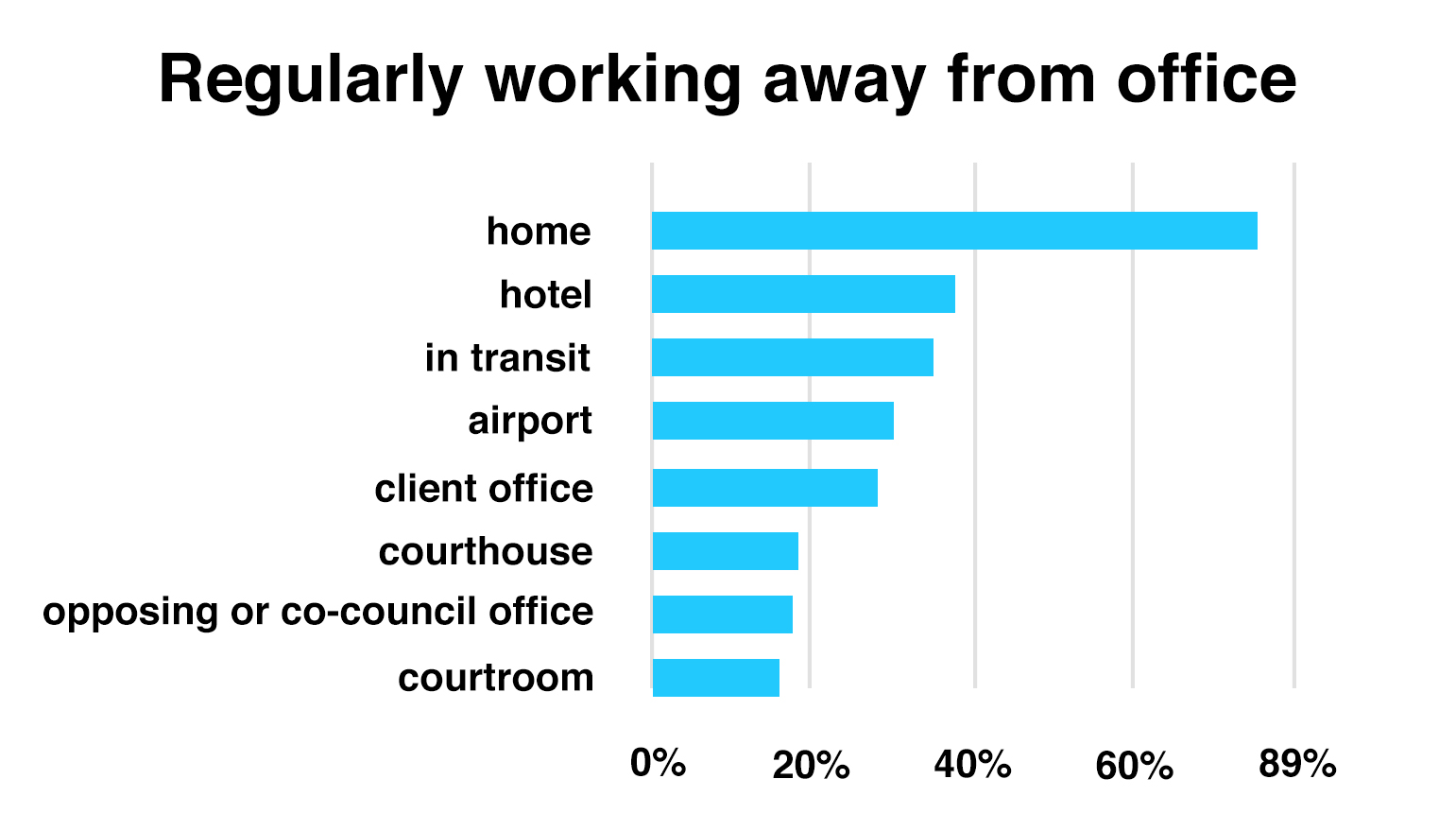But what about teamwork? Collaborating on documents and projects, and broadly sharing knowledge and insight with others in your areas of practice, committees, either at the firm or externally. Email shouldn’t be the first choice for any of those activities. It’s hard for others to find, collaborate or share knowledge if it is stuck in your email inbox. Keeping track of document versions in email after the third version is fraught with frustration. There are much better tools to accomplish those tasks, but legal professionals love email and it’s tough to break old habits.
However, even with email firmly entrenched in the legal industry’s culture, many firms are innovating and adopting new tools and new ways of working together.
Our clients in the legal sector come to us to help them with a digital workplace strategy for a host of reasons. They almost always want to work better, faster and more efficiently. They want to spend less time on documents and matter management and more time working on their cases. Many are looking for ways to reduce overhead, improve service, and be able to securely collaborate on their documents with other attorneys or clients.
The motivation for some is to remain competitive and for others it’s to provide the capabilities and expectations that come from our personal digital workplaces. Increasingly at the forefront of their needs is mobility and having the ability to work anywhere, anytime and to do more faster.
More lawyers are on the move
Law practice now happens outside a law office as much as in it. A growing number of legal professionals work from a home office or shared office space, work while travelling or after going home, or check work email at court.
According to the American Bar Association’s 2016 TechReport, “beyond their primary workspace, lawyers regularly perform legal work outside their office. 77% do legal work from home (not counting those whose primary office is a home office), 38% work while travelling, 28% work remotely from clients’ or opposing counsel’s office, and 19% do work from court.”

The survey also notes that this work outside of the primary office is becoming a very substantial portion of a lawyer’s time too. 15% of legal professionals work remotely at least 10% of the time, 46% work remotely 10-24% of the time, 27% work remotely 25-49% of the time, and 12% of legal professionals work remotely more than half of the time, which begs the question: is their office a primary workplace?
But time is money, and a mobile lawyer has to be able to work efficiently away from the office. To do that requires responsive design and browser based tools and easy access to files and other systems, not clunky VPN’s and security fobs. Keeping everything in sync and always available from any of your multiple devices, requires the capabilities of secure cloud-based services.
“Legal professionals and law firms see them (cloud services) as a fast and scalable way to use advanced legal technology tools without the need for a substantial upfront capital investment in hardware, software, and support services,” writes Dennis Kennedy in his Cloud Computing summary in the 2016 TechReport. “Many traditional software providers are beginning to move to cloud models and offer hosted versions of their products, joining a large number of companies that have focused solely on the cloud.”
Do some lawyers know they are even using the cloud?
Using the cloud has slowly become a standard approach in legal technology and for the past few years held steady at roughly 30% usage from 2013 through 2015. But has the tipping point finally been reached in 2016? Cloud usage grew more than 20% from 2015 to 2016 with solos and small firms leading the way. But are the numbers possibly even higher than that?
Chad Burton, a governing board member of the new ABA Center for Innovation, wonders whether some lawyers understand whether they are using the cloud or not. “A good example of this could be the usage of Microsoft Office 365, which is gaining popularity in law firms,” writes Burton in his TechReport summary of Virtual Law Offices. “Many lawyers may be using 365 (a cloud-based solution for email, calendar, contacts, and other tools), but they don’t realize it is the cloud because much of their interaction with Office 365 is through Outlook—an app they’ve been using for years and years and years. It doesn’t feel any different to them.”
Their use of email creates an opportunity
Burton’s observation presents a powerful strategic opportunity for law firms looking to accelerate their efforts and increase adoption of the new capabilities of a digital workplace and harness the power of the cloud using Office 365. The ubiquitous knowledge, skill, and need that lawyers have to use email, is a perfect way to introduce them to the other powerful tools that today’s legal digital workplace requires, while still working seamlessly alongside the traditional tools like Outlook and Word.
Office 365 is an increasingly powerful platform with many tools that provide a significant start to any organization's digital workplace. The tools that Burton acknowledges as the ones people are already using in the cloud and don’t even realize it, are its most popular components:
- tightly integrated email, calendar and contacts
- the Office suite of tools (Word, Excel & PowerPoint)
- the powerful Skype for Business
- OneDrive for Business
- Yammer
- SharePoint Online
and the other lesser known but equally powerful tools like Delve, Power BI, Groups, and the new Planner.
Our popular What Should I Use and When? infographic explains them all and shows exactly how to expand those entrenched email habits into additional ways of sharing, communicating and collaborating.
What about core legal capabilities?
Yet if we step back from the popular email and documentation capabilities, and even the powerful extended capabilities, there are a few notable gaps in the core legal functionality of Office 365. The 2016 TechReport Survey measured what lawyers considered necessary for work on the go and cloud services. Time and billing led the list at 59%, followed closely by case and matter management (56%), and scheduling and calendaring (55%); all increasing in need from 2015.
To that end, there is a very mature marketplace with plenty of specialized matter management, and time and billing tools, with many being around for decades. Incumbents are moving to browser based interfaces and some now have cloud-based offerings to challenge newcomers. There are also integrators that are helping to connect all of this legacy technology making it easier to be used on the move. But none are really in a good position for the next big step – being a truly integrated “digital workplace” that provides a seamless user experience that brings all the tools you need to get through your day into a consistent interface.
With the surge in lawyer mobility in 2016, there will only be a growing demand for more efficiency and ease of use of a more seamless digital workplace. So what if the tightly integrated email and document tools of Office 365 also had those key matter management and billing functionalities built into it? Too good to be true? Not at all.
Is it time to take another look?
Do you remember Microsoft’s Matter Center? It was originally developed as an in-house solution for Microsoft’s legal affairs team. They thought it was so good they decided to make it commercially available to law firms and legal departments announcing its availability at ILTA’s 2014 conference … but it didn't get much traction. By December 2015, they recharted course and decided to make it available to the public for consumption and contribution as an open-source project on GitHub.
Microsoft followed a few simple principles while developing the Matter Center which separates it from the competition that we were always pleased to see. Specifically they focused the user experience to be centered within Outlook and Word, the email and documentation tools where attorneys spend their time, providing access without installing additional software on the desktop and ensuring all content is available and accessible anywhere, on any device and at any time through Office 365.
If you then consider it takes advantage of all the deep enterprise content management capabilities that the SharePoint platform provides, and offers many additional benefits of being integrated into the Office 365 platform (including: rich content search and discovery with Delve, analytics with Power BI, personal document storage and collaboration with OneDrive for Business, extensive compliance, management and security) and a growing list of capabilities as Office 365 continues to move forward, it is hard to ignore it for tight integration and focus on a legal professional's daily tasks.
By opening it up as open source code, Matter Center partners have made some impressive improvements worth noting such as:
- Robust end-to-end document and email management on Microsoft’s secure and HIPPA compliant cloud platform;
- Centralized deadline management system turning Outlook into a powerful legal calendar and docketing tool synched across all devices;
- Time-tracking component, so lawyers can bill for their time anywhere and anytime;
- Skype for Business integration, to record call time directly to a matter;
- QuickBooks integration for financials.
It’s been a long strange road for Matter Center but its time may have finally come with the increasing need for a tighter integration and ease of use for today’s growing number of mobile legal professionals. For firms ready to make up some serious ground in their digital workplace efforts, it’s hard to beat what is now available with Matter Center and Office 365. Are you one of them?
We can help you with your Office 365 and Matter Center integration or any of your other digital workplace hurdles including strategy, governance, adoption, and change management. Get in touch today. We’d love to help you.





